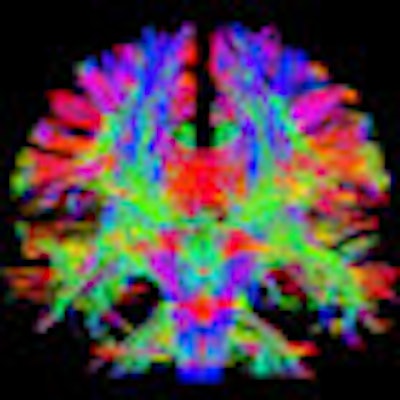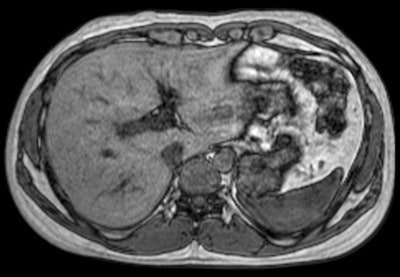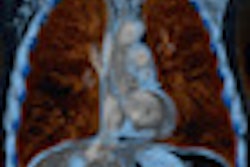
VIENNA - This week the eyes of the radiology world are firmly fixed on events here at the ECR. But in the months leading up to this congress, the major imaging equipment vendors have been looking elsewhere, beyond the borders of Europe to the growing markets of the developing world.
Medical services in countries such as China and India are becoming increasingly sophisticated, and both doctors and patients are demanding the same high-quality diagnostic technology available in developed economies, and some companies in the commercial exhibition at the Austria Center are demonstrating the products that have been specifically developed for these emerging markets. In the current climate of financial austerity, they believe these products are also relevant for Europe.
 Diffusion-tensor imaging can help to improve visualization of white-matter fiber tracts. Image courtesy of Philips.
Diffusion-tensor imaging can help to improve visualization of white-matter fiber tracts. Image courtesy of Philips.A good example is GE Healthcare's Brivo MR355 Inspire, one of two new MRI systems being presented for the first time in Europe. While the other machine, the 1.5-tesla Optima MR360 Advance, is a premium product designed for traditional markets, the Brivo is an entrance-level machine specifically created for use by customers in Asia, South America, and Africa, explained Richard Hausmann, general manager of GE's MRI business.
"The magnets used in Brivo were developed at our U.S. research headquarters, but much of the rest of the system was designed and built in China," he said. "We have a 'distributed' research and development workforce with centers in various parts of the world. There are around 200 engineers based in Beijing working on solutions that are appropriate to the needs of the local market."
The new machine is designed with a smaller footprint than existing devices, and is intended to be simple and economical to install and maintain. The technology may be equally suitable for smaller hospitals in the developed world that are thinking of acquiring their first machine.
"We are trying to bring MR technology to everyone and particularly those living in distant rural areas. The scanner has to be easy to use because the standard of training for technicians may not always be as high as we would want," Hausmann said. "Patient comfort is another important consideration, as patients in developing countries will often be seen at a later stage of the disease process. So, for example, we have designed a low-level table, which very sick people will find easier to get on or off."
 Dynamic liver imaging using the mDixon technique. Complete coverage of the liver is possible in a breath-hold of only 15 seconds. Image courtesy of Philips.
Dynamic liver imaging using the mDixon technique. Complete coverage of the liver is possible in a breath-hold of only 15 seconds. Image courtesy of Philips.Although Brivo is geared for use in emerging markets, GE aims to provide the same diagnostic standards for all its customers. This is part of a broader policy that is attempting to 'humanize' MR procedures and make them a less intimidating experience for patients. The company recognizes that a major cause of patient discomfort is the noise generated within conventional MR systems, which may sometimes reach levels of around 110 dBA -- equivalent to standing next to the speaker stack at a rock concert.
As with the new premium system, Brivo features OpTix Optical RF technology, which offers a high channel count, with analogue to digital signal conversion inside the MR suite to minimize noise and signal degradation, but it operates away from the patient to enhance comfort and safety. GE reckons that OpTix provides up to 27% higher signal-to-noise ratio (SNR) over conventional, analogue signal receivers, improving image quality and clinical confidence.
At ECR, the vendor is also unveiling its new Silent Scan product, which can reduce noise in the MR suite to something equivalent to normal ambient levels.
"Previous acoustic noise mitigation techniques have focused on insulating components and muffling sound rather than treating the noise at the source. With Silent Scan, acoustic noise is essentially eliminated by employing a new advanced 3D acquisition and reconstruction technique called Silenz, in combination with the company's high-fidelity MR gradient and RF system electronics," Hausmann said.
Expanding on its global R&D footprint that includes a new high-tech facility in Suzhou, China, Philips has developed a reliable and simple to use machine for developing markets. The Multiva 1.5-tesla unit is designed to ease patient discomfort and increase productivity by reducing the time spent setting up an examination. It features the FlexStream workflow system, which enables efficient handling of coils for head, spine, musculoskeletal, and neurovascular examinations, allowing a reduction of up to 40% in the time it takes to position the patient and coils before securing an image, according to the manufacturer.
 Left: MR image of the posterior triangle of the neck using the DWIBS (diffusion-weighted whole-body imaging with background body subtraction) technique. Right: High-resolution, proton density-weighted image of the ankle. Images courtesy of Philips.
Left: MR image of the posterior triangle of the neck using the DWIBS (diffusion-weighted whole-body imaging with background body subtraction) technique. Right: High-resolution, proton density-weighted image of the ankle. Images courtesy of Philips.Another feature of the Multiva system is SmartSelect software, which automatically determines which coils and elements should be activated to yield the maximum SNR in the region of interest for greater efficiency and higher image resolution. Additionally, a large neurovascular coil design allows patients to use headphones during their examination, which can help improve patient comfort. These improvements will maximize the value of the system and allow clinicians to treat more patients each day without compromising image quality, the company explained.
Meanwhile, Hitachi Aloka Medical Systems believes that tackling patients' anxiety and their feelings of claustrophobia is as important as controlling noise during a procedure. Moreover, it can also make life easier for the medical staff by reducing the number of examinations that have to be aborted because of anxious patients.
The company has pioneered a novel oval-shaped bore for its devices to more accurately reflect the typical human body shape. The idea was introduced last year with its 1.5-tesla Echelon Oval system, and now Hitachi has developed the 3-tesla Trillium Oval machine to support the increasing application of high-field machines in routine procedures.
As with the Echelon Oval, the new system has a 74-cm bore, giving greater comfort than the 60 cm available in standard 1.5-tesla MR units or the 70 cm offered with the latest generation of wide-bore magnets. Other features intended to improve patient comfort include a 63-cm-wide mobile table with a 250-kg weight capacity and retractable arm boards for better patient safety, along with "feet-first" imaging as standard for all procedures.
Siemens Healthcare is introducing a 3-tesla machine and is emphasizing its value as a research tool in neurology, physiology, and tissue metabolism studies. The company believes that the Magnetom Prisma sets new standards, having a gradient strength of 80 mtesla/m combined with a slew rate of 200 tesla/m/sec.


 Anatomical details of the brain, knee, and head viewed with the new Magnetom Prisma 3-tesla MRI system. The machine combines high gradient strength and fast gradient slew rates in a way that is unprecedented for commercial whole-body systems worldwide, according to the manufacturer. Images courtesy of Siemens Healthcare.
Anatomical details of the brain, knee, and head viewed with the new Magnetom Prisma 3-tesla MRI system. The machine combines high gradient strength and fast gradient slew rates in a way that is unprecedented for commercial whole-body systems worldwide, according to the manufacturer. Images courtesy of Siemens Healthcare.The system also offers a tandem configuration unavailable in any other commercial whole-body system, according to the vendor. The device's combination of high gradient strength and fast gradient switching speed allows for increased image quality compared with conventional devices. Due to this combination of high spatial and temporal resolution, the new machine can reportedly achieve good image quality, especially in very demanding applications. Furthermore, by combining high gradient strength with fast gradient switching speed, the Magnetom Prisma offers new possibilities in areas such as diffusion imaging, because even minor diffusion effects can be captured. Moreover, the diffusion spectrum imaging (DSI) application makes it possible to resolve fine anatomical details of the brain, such as crossing white-matter fibers by using up to 514 diffusion encoding directions, Siemens stated.
At Toshiba's ECR booth, employees are keen to demonstrate the potential advantages of an upgrade for the M-Power operating system in improving workflow. These enhancements are available on its Vantage Titan 1.5- and 3-tesla MR systems. They help to create a user-friendly interface that simplifies both acquisition and postprocessing and that streamlines many of the time-consuming steps used in routine clinical scans, according to the company.
Originally published in ECR Today on 9 March 2013.
Copyright © 2013 European Society of Radiology


.fFmgij6Hin.png?auto=compress%2Cformat&fit=crop&h=100&q=70&w=100)





.fFmgij6Hin.png?auto=compress%2Cformat&fit=crop&h=167&q=70&w=250)











